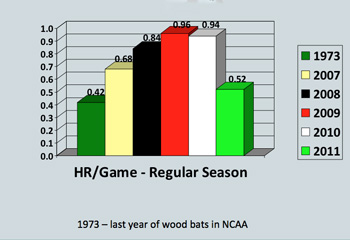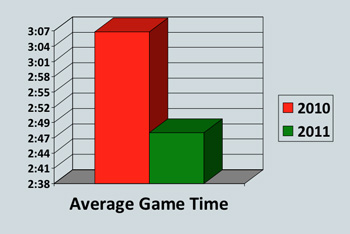Baseball is considered relatively safe, but its reputation was established in the era of wooden bats. Aluminum bats, introduced in the 1970s, had an enormous “trampoline effect” and made the game more dangerous.

A 90-mph pitch could come off a lively aluminum bat at 108 mph and reach the pitcher 0.375 seconds later, leaving him no time to react when the ball was hit right back at him.
In fact, several high school players were severely injured and at least two killed by scorching line drives.
In 2003, 18-year-old Brandon Patch was killed by a line drive when he was pitching for his team in Montana. In 2009, his family won a verdict against the maker of the Louisville slugger for his death.
In 2010, a 13-year-old Vermont pitcher also was killed by a line drive.
Last year, the National Collegiate Athletic Association required all aluminum bats used in college play to meet a new performance standard designed to limit the exit speed of the ball off the bat. This year, the National Federation of State High School Associations also has implemented the new standard.
With spring training beginning at all levels this month, David A. Peters, PhD, the McDonnell Douglas Professor of Engineering in the Department of Mechanical Engineering & Materials Science at Washington University in St. Louis, explains the new standard.
WUSTL baseball head coach Steve Duncan, and WUSTL hitting coach and Rawlings category manager for bats Kyle Murphy also comment on the new bats and how they have affected play.
First the balls
Peters, an avid baseball fan, has made 32 video vignettes about the physics of baseball for Cardinal Nation, the St. Louis Cardinals fan club.
“Three things come into play when a baseball comes off a bat,” Peters says. “The speed of the balls coming in; the speed the bat’s being swung — the speed of the bat hit; and then how much energy is lost in that collision.”
The energy lost in the collision depends on how bouncy the ball is and how springy the bat. That bounciness, or springiness, is technically known as the coefficient of restitution, a measure of how much energy the ball or bat gives back after being deformed by an impact.
As a general rule, wood bats made of white ash, the traditional material, give very little and store little energy. But what little they store they give back efficiently. The ball, on the other hand, distorts a lot under impact but is relatively inefficient in giving it back, losing the kinetic energy as heat. This is why a game played with wood bats is relatively safe.
But players are always trying to figure an angle, Peters says.
In the early days of the game, it was often the ball that was “cooked” or “juiced,” so in the late 1960s a standard was introduced to limit variations among balls.
The rule is that a ball shot from an air cannon at 85 feet per second at a wall of northern white ash must rebound with a speed of between 43.7 and 49.1 feet per second.
That gives it a coefficient of restitution of about 0.55, meaning the ball loses in the impact roughly 70 percent of the energy it had coming in.
In contrast, a golf ball is much bouncier; it has a coefficient of restitution of about 0.78.
Then the bats
Hot bats became an issue when aluminum bats were introduced in the 1970s. Because aluminum bats are lighter, they can be swung faster than a wooden bat, and that made the balls come off faster.
The big difference between the wooden and aluminum bats, however, was again the coefficient of restitution, called the trampoline effect in the case of the bats.
The hollow aluminum bats flex more when they’re hit and allow the bat to stay in contact for a longer time, imparting more energy to the ball.
Peters says we’ve all seen the difference this makes in the sport of pole vaulting. The poles, like the bats, were originally made of ash but are now made of tubular aluminum.
“The old poles were rigid,” he says, “but now the pole bends halfway down and springs back, flipping the vaulter over the bar.
“Aluminum bats can be engineered to have any amount of rebound one wants by designing the thickness and shape distribution of the bat,” he says.
In fact, after the introduction of aluminum bats, bat designers went a bit overboard. Bats made of titanium, for example, had such an enormous trampoline effect that they were quickly banned.
Another troublesome design that resulted in law suits was the “Air Attack” bat made by Louisville Slugger. It has a pressurized bladder inside that compresses on impact and then expands fast enough to help propel the ball.
The new bat standard
The old standard for bats, Peters explains, was the Ball Exit Speed Ratio, or BESR standard. A simple ratio, it consisted of the speed of the ball coming in divided by its speed going out.
“Now they’re saying that doesn’t really tell you much about the bat, because many factors contribute to those speeds,” Peters says.
The new standard, the Bat-Ball Coefficient of Restitution, or BBCOR, includes the same speed ratio but adds a correction for the coefficient of restitution of the ball used in the test and another correction for the coefficient of restitution of the bat.
According to the standard, a bat’s BBCOR can be no higher than 0.500, meaning that a ball will give up half of its energy in its collision of the bat.
The effect of the standard is to deaden aluminum bats, making them perform more like the traditional white ash bats —but not quite.
According to lab studies, the BBCOR of an old BESR aluminum bat is about 15.5 percent higher than the BBCOR of a wood bat while the new aluminum bats have a BBCOR 10.7 percent higher than wood bats.
Peters, for one, isn’t sorry to see the new standard put in place. Baseball has been and should remain a game of strategy rather than of speed, he says.
What it means for play
At a clinic for St. Louis-area high school coaches Feb 11, Duncan spoke about the effects the new bats had on NCAA play last year.

Steve Duncan with data from Gary Brown, NCAA
Home runs per game peaked in the last three years in which the NCAA used BESR bats bats (2007-2010). Wood bats were last used in the NCAA in 1973.
In the last three years in which the NCAA used BESR bats, runs increased 14 percent and home runs increased by 38 percent, Duncan says. “In general, the BESR bats shifted the advantage from the defense to the offense.
“The BBCOR bats diminish offense. If statistics are a guide, they effectively take the offensive side of the game back to the 1970s,” Duncan says. “We’re seeing nearly the same statistics as in 1973, the last year that wood bats were used in the NCAA.”
In general, he told the coaches, expect:
- Quicker games;
- Less offense;
- Need for better hitting fundamentals, players must swing; faster and more accurately to get the same results;
- Increased emphasis on speed;
- Increased emphasis on defense;
- Increased emphasis on pitching; and
- Need for improved strength and coordination; bat is weaker so players need to be stronger.

Steve Duncan with data from Gary Brown, NCAA
One nonobvious consequence of the change to BBCOR bats in the NCAA is that games are now half an hour shorter than they were the last year BESR bats were used.
“I’m a fan of the new regulations,” Duncan says. “By reducing the margin of error, they benefit the good players at the expense of players who had poor hitting fundamentals but were saved by a bat that could perform miracles.”
How the bats are made
According to Murphy, the challenge with the BESR bats was to make the walls as thin as possible to get the most rebound. “And of course you could make the walls thinner with higher grades of alloy and then with composites when they came into the game,” he says.
“In order to pass BBCOR, you had to make the walls much thicker. There are a couple of ways of doing that. Some makers have put metal rings inside the bats. Like putting cinder blocks under a trampoline, that limited the rebound of the bat.
“At Rawlings, we took a different approach,” he says. “We used what’s called a double-butting procedure, and the bat is thin-walled all the way up to the sweet spot, or where the BBCOR test is taken. It’s a thicker wall in that region and then we thin it out again at the end.
“That way, BBCOR bats are better balanced. We’re trying to make the best-balanced bat on the market. The more balanced the bat, the faster the bat speed, the faster the bat speed, the farther the ball will go.”
Murphy also likes what the new standard is doing to the game.
“I think it really brings pitching back into the game,” he says. “It’s going to make the player a whole lot better. There’s such a thing as an ‘aluminum bat swing,’ and that was guys who weren’t mechanically right with their swings but could get away with it because they could hit singles or doubles off their hands or off the end of the bat.
“Now you have to focus on your fundamentals because you’re not going to get away with a ball off the hands being a single anymore.
“It’s also good for scouting,” he says, “because they can really evaluate which players are going to be able to transition to a wood bat in the pros.
“It’s a different game now with BBCOR, but it’s all for the better,” Murphy says.

